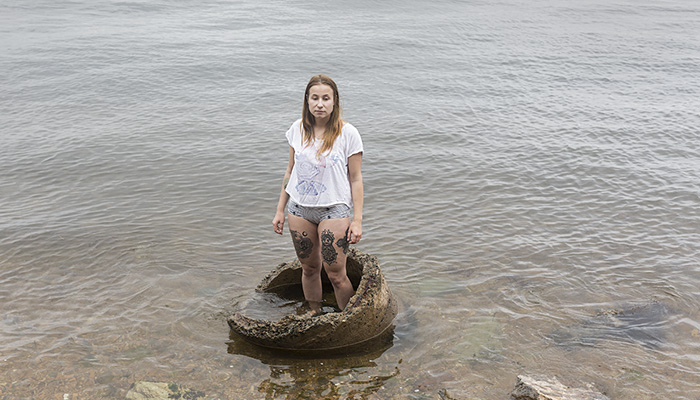
SEPTEMBER 1 - 23
Research into the interplay between the Russian and Asian cultures coexisting in Vladivostok forms the basis of Siberian artist Elena Anosova’s latest body of work, on view at the Zarya Center for Contemporary Art. By exhibiting the resulting body of work in Vladivostok itself, Anosova offers a glimpse into the deeply personal, isolated experience of an artist immersed in the subject of her research, while at the same time providing autonomous (and long-awaited) documentation on what happens when two cultures occupy the same space.
A documentary researcher, Anosova uses her project, “Polite Fish,” to identify pressure points in the exchanges between the two cultures as well as their mutual influence on one another in moments of encounter, such as interethnic marriages, the city’s spin on Asian forms of collective sports or music, or interventions of elements of Asian urban architecture within the local landscape. Applying the traditional research method of immersion, Anosova explores the phenomenon of the “polite fish” – a situation of contradictions between two opposite poles, two sides of the same coin, highlighting the difference between an external show of politeness and the internalized wariness inherent to the Asian world.
The problem of identity for a Russian living in the Primorsky Krai is that the more one emphasizes one’s “Russian-ness”, the more one starts to resemble their Asian neighbor, for whom this Russian is often the first experience of a cultural “Other.”
The permanent oppositions between male and female, young and old, the collective and the individual, East and West (the meeting of the yin and the yang) reveal themselves most clearly at the boundary lines, and so it is along these borders that Anosova positions her project, “Polite Fish.”
An attempt to locate contemporary equivalents for the perspectives and beliefs around the historic context of the Primorsky territory can be found in the visual metaphors of Anosova’s update of Botticelli’s Birth of Venus (a girl standing on a piece of concrete, as if on the verge of something new, in the open port of Vladivostok) or Rubens’s Venus Frigida " (a girl with an infant tied to her back, squatting down in a rock garden, as if hoping to escape notice while still drawing nearer to nature.)
New cars, drowning in overgrown grass on the Zelenka; the Wushu fighters on the Nabka; a lake of lotuses in the very bosom of nature; or the concrete jungle of a campus with its sterile embankment – in taking in these more or less common portrayals of the city, a local viewer might be startled to learn that the center of Vladivostok now has a playground with Chinese characters, or that the village of Razdolnyi hosts a children’s paramilitary camp every summer. In these images, we are seeing ourselves in here and now: faces hidden, borders blurred, Asians in a European society, Europeans with an Asian mentality. The natural habitat of our heroes and the natural plasticity of the figures themselves “disappear” into their city like a fish into water.
This is not the first time Anosova has taken this kind of approach in her work. Her earlier series,“Saagan Sag,” was developed over three years spent researching the overlap of two cultures living in the same territory – in this case, Russians and Buryats in Siberia.
Quite possibly one of the most important bodies of photography today, Anosova’s trilogy “Section,” provides a glimpse into contemporary women’s penal institutions. The first part was shot in Siberian labor camps and has been published as an album.
Elena Anosova (born in 1983) is a documentary photographer living and working in Irkutsk and Moscow. In 2013, she enrolled in the Rodchenko Moscow School of Photography and Multimedia. In 2015, she won the grand prix of the Andrei Stenin International Press Photo contest as well as the top prize for documentary photography at the Baltic Biennale Photomania-2015. She has previously been recognized as the winner of the “Young Photographers of Russia” contest and received a scholarship for young artists from the Ministry of Culture of the Russian Federation.
This exhibition would not have been possible without the efforts of: Alisa Bagdonayte, Tanya Bogacheva, Yana Gaponenko, Maria Zhuravleva, Vyacheslav Merkurev, Anton Nedotsukov, Tatiana Olgesashvili, Alexandra Rudenko.
The artist would like to extend her gratitude to: Elena Belova, Ruslan Belik and Hae Dong, Ekaterina Belyaeva, Vladimir Bobyrev, Anton Bubnovsky, Alexander Gorodnyi, Vitaly Dudko, Vyacheslav Igoshin, Polina Kampioni, Elena Kerbel, Vladimir Kolchin, Larisa and Andrei Konischev, Sergei Kornilov, Kirill Kryuchkov, Valeria Kuzora, Anton Kuklin, Dmitry Kumanev, Elena Lee, Olga, Aleksey and Marina Lee, Yury Lugansky, Vadim Martynenko, Petr Molodov, Raisa Moroz, Andrey Nikitin, Sergei Orlov, Mikhail Pavin, Anna Pastukhova, Oleg and Margarita Petrukh, Ivan Proskurin, Baek Tereza and Viktor Radionov, Svetlana Rybalko, Xu Yi Ping., Yury Smityuk, Anastasia Statsenko, Valeria Fedorenko, Galina Tsesarskaya, Viktor Shalai, Dmitry Shemetov, and Pavel Shugurov.